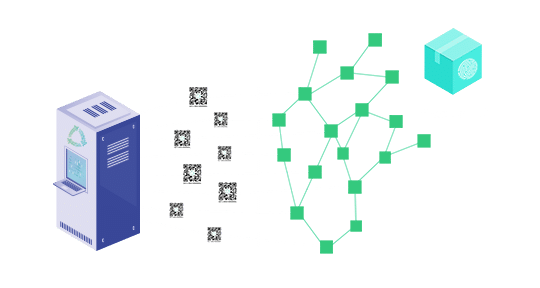The Path to the Deposy Product ID
From the manufacturer request via the Deposy-NTA to the individual IOTA transaction

The Deposy Product ID is a central component of the entire Deposy deposit system. It serves to identify the individual types of plastic in the machine. In addition, this product ID can contain much more information. This is valuable for the future operation of the system. For example, in addition to the exact plastic composition, the recycling proportion or CO2 emission of the production can be stored there.
This is important data for the “footprint” of the product. It’s relevant for the vending machine, the recycler or reuser, and it’s also becoming increasingly important for the environmentally friendly consumer. The plastics producer gets immutable evidence of the percentages of his plastic products that go through the recycling process.
This data can become highly significant for producers in the near future. On 01.31.2020, the city of Tübingen decided on a tax on packaging. It’s conceivable that future taxes of this kind can be compensated by a recycling quota.
In recent weeks we have been frequently asked how the interaction between Product ID, Deposy-NTA and the individual transaction actually works. With this blog post we want to contribute to the understanding. We show the individual steps that are necessary to implement a Product ID in the Deposy system.
- The Deposy server receives a manufacturer request for the Product ID
- The server automatically processes all data in the request (generates QR codes, wallets, etc.)
- The server opens a session. This is necessary to start a transaction.
- The transaction is automatically prepared and sent to the tangle.
- The system waits until the transaction is confirmed. If this takes too long, an automatic “reattach” is performed. This means that the transaction will be reattached to another point in the tangle if the bundle has reached a dead end.
- If the transaction is confirmed the QR code is sent to the vendor and the session is closed.
- The manufacturer can process the QR code and release it into the market.
The Deposy team has developed the NTA (Non Transactiontime Algorithm). This allows to generate product IDs without dependence on transaction times. The major progress is that the work orders can be processed quickly and huge amounts of Deposy Product IDs can be generated in a very short time. This is necessary to successfully implement the Product ID in the Deposy project on an industrial scale.
The NTA itself enables the session to be used by distributing the addresses. If the NTA would not be used, each new transaction would have to wait until the previous one is confirmed before the next Product ID can be initiated.
To illustrate the confirmation of a transaction in the deposit system, we have created a short video. It shows the following steps:
- A transaction (Product ID) is prepared in a bundle and then attached to the tangle.
- After attaching, the tangle is automatically asked at intervals whether the transaction is confirmed.
- If the transaction is “pending” for a long time, the transaction is “reattached” again.
- At the end you can see that the transaction is confirmed and the product (Product ID) is successfully stored on the tangle.